Abstract
Degenerated intervertebral disc has lost its normal architecture, and there are changes both in the nuclear and annular parts of the disc. Changes in cell shape, especially in the annulus fibrosus, have been reported. During degeneration the cells become more rounded, chondrocyte-like, whereas in the normal condition annular cells are more spindle shaped. These chondrocyte-like cells, often forming clusters, affect extracellular matrix turnover. In previous studies transforming growth factor β (TGFβ) −1 and −2, basic fibroblast growth factor (bFGF) and platelet-derived growth factor (PDGF) have been highlighted in herniated intervertebral disc tissue. In the present study the same growth factors are analysed immunohistochemically in degenerated intervertebral disc tissue. Disc material was obtained from 16 discs operated for painful degenerative disc disease. Discs were classified according to the Dallas Discogram Description. Different disc regions were analysed in parallel. As normal control disc tissue material from eight organ donors was used. Polyclonal antibodies against different growth factors and TGFβ receptor type II were used, and the immunoreaction was detected by the avidin biotin complex method. All studied degenerated discs showed immunoreactivity for TGFβ receptor type II and bFGF. Fifteen of 16 discs were immunopositive for TGFβ-1 and −2, respectively, and none showed immunoreaction for PDGF. Immunopositivity was located in blood vessels and in disc cells. In the nucleus pulposus the immunoreaction was located almost exclusively in chondrocyte-like disc cells, whereas in the annular region this reaction was either in chondrocyte-like disc cells, often forming clusters, or in fibroblast-like disc cells. Chondrocyte-like disc cells were especially prevalent in the posterior disrupted area. In the anterior area of the annulus fibrosus the distribution was more even between these two cell types. bFGF was expressed in the anterior annulus fibrosus more often in chondrocyte-like disc cells than in fibroblast-like disc cells. Control discs showed cellular immunopositivity for only TGFβ-1 and −2 and TGFβ receptor type II . We suggest that growth factors create a cascade in intervertebral disc tissue, where they act and participate in cellular remodelling from the normal resting stage via disc degeneration to disc herniation.


Similar content being viewed by others
References
Alini M, Li W, Markowic P, et al. (2003) The potential and the limitations of a cell-seeded collagen/hyaluronan scaffold to engineer in intervertebral disc like matrix. Spine 28:446–454
Burke JG, Watson RWG, Conhyea D et al (2003) Human nucleus pulposis can respond to a pro-inflammatory stimulus. Spine 28:2685–2693
Fraser RD, Osti OL, Vernon-Roberts B (1993) Intervertebral disc degeneration. Eur Spine J 1:205–213
Gibson MJ, Buckley J, Mawhinney R, Mulholland RC, Worthington BS (1986) Magnetic resonance imaging and discography in the diagnosis of disc degeneration. J Bone Joint Surg [Br] 68:369
Gruber HE, Fisher EC Jr, Desai B et al (1997) Human intervertebral disc cells from the annulus: three-dimensional culture in agrose or alginate and responsiveness to TGF-beta1. Exp Cell Res 235:13–21
Gruber HE, Hanley EN (2000) Human disc cells in monolayer vs 3D culture: cell shape, division and matrix formation. BMC Musculoskelet Disord 1:1–9
Konttinen YT, Kemppinen P, Li P et al (1999) Transforming and epidermal growth factors in degenerated intervertebral discs. J Bone Joint Surg [Br] 81:1058–1063
Kääpä E, Wang W, Takala TE et al (2000) Elevated protein content and prolyl 4-hydroxylase activity in severely degenerated human annulus fibrosus. Connect Tissue Res 2:93–99
Melrose J, Smith S, Little CB et al (2002) Spatial and temporal localization of transforming growth factor beta, fibroblast growth factor-2, and osteonectin, and identification of cells expressing alpha-smooth muscle actin in injured anulus fibrosus: implication for extracellular matrix repair. Spine 27:1756–1764
Minamide A, Hashizume H, Yoshida M et al (1999) Effects of basic fibroblast growth factor on spontaneous resorption of herniated intervertebral discs. An experimental study in the rabbit. Spine 24:940–945
Nachemson A (1965) In vivo discometry in lumbar discs with irregular nucleograms. Acta Orthop Scand 36:418–434
Nagano T, Yonenobu K, Miyamoto S et al (1995) Distribution of the basic fibroblast growth factor and its receptor gene expression in normal and degenerated rat intervertebral discs. Spine 20:1972–1978
Nomura T, Mochida J, Okuma M, Nishimura K, Sakabe K (2001) Nucleus pulposus allograft retards intervertebral disc degeneration. Clin Orthop 389:94–101
Oegema TR, Johnson SL, Aguiar DJ, Ogilvie JW (2000) Fibronectin and its fragments increase with degeneration in the human intervertebral disc. Spine 21:2742–2747
Okuma M, Mochida J, Nishimura K, Sakabe K, Seiki K (2000) Reinsertion of stimulated nucleus pulposus cells retards intervertebral disc degeneration: an in vitro and in vivo experimental study. J Orthop Res 18:988–997
Osti OL, Fraser RD (1992) MRI and discography of annular tears and intervertebral disc degeneration. A prospective clinical comparison. J Bone Joint Surg [Br] 74:431–435
Pattison ST, Melrose J, Ghosh P, Taylor TK (2001) Regulation of gelatinase-A (MMP-2) production of ovine intervertebral disc nucleus pulposus cells grown in alginate culture by transforming growth factor-β(1) and insulin growth factor-I. Cell Biol Int 25:679–689
Pritzher KPH (1977) Aging and degeneration in the lumbar intervertebral disc. Orthop Clin N Am 8:65–77
Roberts S, Caterson B, Menage J, Evans EH, Jaffray DC, Eisenstein SM (2000) Matrix metalloproteinases and aggrecanase: their role in disorders of the human intervertebral disc. Spine 23:3005–3013
Sachs BL, Vanharanta H, Spivey MA et al (1987) Dallas Discogram Description. A new classification of CT/discography in low-back disorders. Spine 12:287–294
Schneiderman G, Flannigan B, Kingston S, Thomas J, Dillin WH, Watkins RG (1987) Magnetic resonance imaging in the diagnosis of disc degeneration: correlation with discography. Spine 12:276–281
Schollmeier G, Lahr-Eigen R, Lewandrowski KU (2000) Observations on the fiber-forming collagens in the annulus fibrosus. Spine 21:2736–2741
Specchia N, Pagnotta A, Toesca A et al (2002) Cytokines and growth factor in the protruded intervertebral disc of the lumbar spine. Eur Spine J 11:145–151
Thompson JP, Pearce RH, Schechter MT, Adams ME, Tsang IKY, Bishop PB (1990) Preliminary evaluation of a scheme for grading the gross morphology of the human intervertebral disc. Spine 15:411–415
Thompson JP, Oegema TR Jr, Bradford DS (1991) Stimulation of mature canine intervertebral disc by growth factors. Spine 16:253–260
Tolonen J, Grönblad M, Virri J, Seitsalo S, Rytömaa T, Karaharju E (1995) Basic fibroblast growth factor immunoreactivity in blood vessels and cells of disc herniation. Spine 20:271–276
Tolonen J, Grönblad M, Virri J, Seitsalo S, Rytömaa T, Karaharju EO (1997) Platelet-derived growth factor and vascular endothelial growth factor expression in disc herniation tissue: an immunohistochemical study. Eur Spine J 6:63–69
Tolonen J, Grönblad M, Virri J, Seitsalo S, Rytömaa T, Karaharju E (2001) Transforming growth factor beta receptor induction in herniated intervertebral disc tissue: an immunohistochemical study. Eur Spine J 10:172–176
Tolonen J, Grönblad M, Virri J, Seitsalo S, Rytömaa T, Karaharju E (2002) Oncoprotein c-Fos and c-Jun immunopositive cells and cell clusters in herniated intervertebral disc tissue. Eur Spine J 11:452–458
Weidenbaum M, Foster RJ, Best BA et al (1990) Correlation of magnetic resonance imaging with the biochemical content of the normal human intervertebral disc. J Orthop Res 10:552–561
Acknowledgements
Financial support from the Paulo Foundation, the Yrjö Jahnsson Foundation and research funding from Helsinki University Central Hospital is gratefully acknowledged.
Author information
Authors and Affiliations
Corresponding author
Rights and permissions
About this article
Cite this article
Tolonen, J., Grönblad, M., Vanharanta, H. et al. Growth factor expression in degenerated intervertebral disc tissue. Eur Spine J 15, 588–596 (2006). https://doi.org/10.1007/s00586-005-0930-6
Received:
Revised:
Accepted:
Published:
Issue Date:
DOI: https://doi.org/10.1007/s00586-005-0930-6




